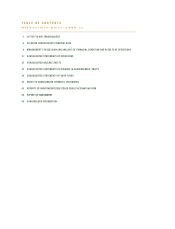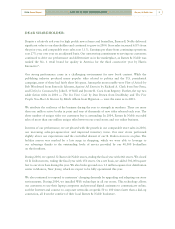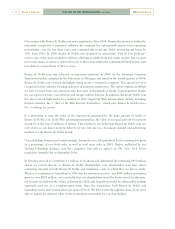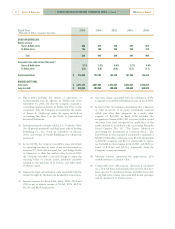Barnes and Noble 2004 Annual Report Download - page 13
Download and view the complete annual report
Please find page 13 of the 2004 Barnes and Noble annual report below. You can navigate through the pages in the report by either clicking on the pages listed below, or by using the keyword search tool below to find specific information within the annual report.
11
2004 Annual Report Barnes & Noble, Inc.
[MANAGEMENT’S DISCUSSION AND
ANALYSIS OF FINANCIAL CONDITION AND RESULTS
OF OPERATIONS continued ]
all of its Class B common stock in GameStop Corp.
(GameStop), the Company’s Video Game operating
segment. This disposition was completed in two steps.
The first step was the sale of 6,107,338 shares of
GameStop Class B common stock held by the Company
to GameStop (Stock Sale) for an aggregate
consideration of $111.5 million. The Stock Sale was
completed on October 1, 2004. The second step in the
disposition was the spin-off by the Company of its
remaining 29,901,662 shares of GameStop’s Class B
common stock (Spin-Off). The Spin-Off was completed
on November 12, 2004 with the distribution of
0.424876232 of a share of GameStop Class B common
stock as a tax-free distribution on each outstanding
share of the Company’s common stock to the
Company’s stockholders of record as of the close of
business on November 2, 2004. As a result of the Stock
Sale and the Spin-Off, GameStop is no longer a
subsidiary of the Company. The disposition of all of the
Company’s stockholdings in GameStop resulted in the
Company presenting all historical results of operations
of GameStop as discontinued operations.
CRITICAL ACCOUNTING POLICIES
Management’s Discussion and Analysis of Financial
Condition and Results of Operations discusses the
Company’s consolidated financial statements, which
have been prepared in accordance with accounting
principles generally accepted in the United States. The
preparation of these financial statements require
management to make estimates and assumptions in
certain circumstances that affect amounts reported in the
accompanying consolidated financial statements and
related footnotes. In preparing these financial statements,
management has made its best estimates and judgments
of certain amounts included in the financial statements,
giving due consideration to materiality. The Company
does not believe there is a great likelihood that materially
different amounts would be reported related to the
accounting policies described below. However,
application of these accounting policies involves the
exercise of judgment and use of assumptions as to future
uncertainties and, as a result, actual results could differ
from these estimates.
Other Long-Lived Assets
The Company’s other long-lived assets include property
and equipment and amortizable intangibles. At January
29, 2005, the Company had $804.7 million of property
and equipment, net of accumulated depreciation, and
$19.4 million of amortizable intangible assets, net of
amortization, accounting for approximately 24.6% of
the Company’s total assets. The Company reviews its
long-lived assets for impairment whenever events or
changes in circumstances indicate that the carrying
amount of an asset may not be recoverable in
accordance with Statement of Financial Accounting
Standards (SFAS) No. 144, “Accounting for the
Impairment or Disposal of Long-Lived Assets”. The
Company evaluates long-lived assets for impairment at
the individual store level, which is the lowest level at
which individual cash flows can be identified. When
evaluating long-lived assets for potential impairment,
the Company will first compare the carrying amount of
the assets to the individual store’s estimated future
undiscounted cash flows. If the estimated future cash
flows are less than the carrying amount of the assets, an
impairment loss calculation is prepared. The impairment
loss calculation compares the carrying amount of the
assets to the individual stores fair value based on its
estimated discounted future cash flows. If required, an
impairment loss is recorded for that portion of the asset’s
carrying value in excess of fair value.
Goodwill and Unamortizable Intangible Assets
At January 29, 2005, the Company had $268.4 million
of goodwill and $78.1 million of unamortizable
intangible assets (i.e. those with an indefinite useful
life), accounting for approximately 10.3% of the
Company’s total assets. SFAS No. 142, “Goodwill and
Other Intangible Assets”, requires that goodwill and
other unamortizable intangible assets no longer be
amortized, but instead be tested for impairment at least
annually or earlier if there are impairment indicators.
The Company performs a two-step process for
impairment testing of goodwill as required by SFAS No.
142. The first step of this test, used to identify potential
impairment, compares the fair value of a reporting unit
with its carrying amount. The second step (if necessary)
measures the amount of the impairment. The Company
completed its annual impairment test on the goodwill in
November 2004 and deemed that no impairment
charge was necessary. The Company has noted no
subsequent indicators of impairment. The Company
tests unamortizable intangible assets by comparing the
fair value and the carrying value of such assets.
Changes in market conditions, among other factors,
could have a material impact on these estimates.
Closed Store Expenses
When the Company closes or relocates a store, the
Company charges unrecoverable costs to expense. Such
costs include the net book value of abandoned fixtures
and leasehold improvements and, when a store is closed,
a provision for future lease obligations, net of expected
sublease recoveries. Costs associated with store closings
of $6.5 million, $5.7 million and $9.8 million during
fiscal 2004, 2003 and 2002, respectively, are included in
selling and administrative expenses in the accompanying
consolidated statements of operations.
























